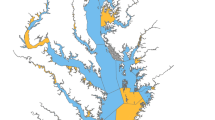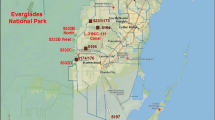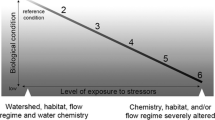Abstract
A taxonomy of environmental indicators was developed to inform management of aquatic ecosystems, and its utility was evaluated through application within the Chesapeake Bay Program. We considered a set of 82 metrics generated by this Program, using qualitative assessment of descriptive materials. We found that 30 of these metrics conveyed sufficient information about the larger system to be considered true indicators. These 30 were classified according to the proposed taxonomy into one or more of five types: condition, evaluation, diagnostic, communication, or futures. We also evaluated the scales at which these indicators function temporally and spatially. We conclude that only a limited number of indicators are designed to be diagnostic and/or designed to forecast future conditions. The scale analyses suggest the indicator set is not focused on local scales and/or the watershed component of the Bay system. The taxonomy succeeds in framing an assessment of existing indicator sets that can productively guide future development efforts.
Similar content being viewed by others
Reference
Barber MC (editors) (1994) Indicator Development Strategy, EPA/620/R-94/022, U.S. Research Triangle Park, NC: Office of Research and Development, Environmental Protection Agency
Belfiore S, Balgos M, Galofre J, McLean B, Blaydes M, Tesch D (2002) Background Paper for International Workshop on the Role of Indicators in Integrated Coastal Management in Ottawa, Canada, Newark, DE: Center for the Study of Marine Policy, University of Delaware
Bernhardt ES, Palmer MA, Allan JD, Alexander G, Barnas K, Brooks S, et al. (2005) Synthesizing U.S. River Restoration Efforts. Science 308:636–637
Chesapeake Bay Program (2000) Chesapeake 2000. Available: http://www.chesapeakebay.net/agreement.htm [accessed February 19, 2007]
EPA (1992) Framework for Ecological Risk Assessment, EPA/630/R-92/001. Washington, DC: Office of Research and Development, U.S. Environmental Protection Agency
Jackson LE, Kurtz JC, Fisher WS (editors) (2000) Evaluation Guidelines for Ecological Indicators, EPA/620/R-99/005, Research Triangle Park, NC: Office of Research and Development, U.S. Environmental Protection Agency, 107 p
NOAA (2002) National Coastal Zone Indicators: An Assessment of Indicator Use and Potential in Five Coastal States. Draft presented at the National Program Managers’ Meeting in Silver Spring, MD, March 2002, Washington, DC: NOAA
OECD (1993) OECD Core Set of Indicators for Environmental Performance Reviews, Environment Monograph No. 83, Paris: Organization for Economic Cooperation and Development
United States Government Accountability Office (2004) Environmental Indicators: Better Coordination Is Needed to Develop Environmental Indicator Sets That Inform Decisions. Report to Congressional Requesters, GAO-05-52, November 2004, 120 p
United States Government Accountability Office (2006) Chesapeake Bay Program: Improved Strategies Are Needed to Better Assess, Report, and Manage Restoration Progress. Report to Congressional Requesters, GAO-06-96, October 2005, 92 p
Wardrop D, Hershner C, Thornton K, Havens KJ, Bilkovic D, Baker M (2007) A taxonomy and framework for ecological indicators. EcoHealth 4:this issue
Acknowledgments
This research has been supported by a grant from the U.S. Environmental Protection Agency’s Science to Achieve Results (STAR) Estuarine and Great Lakes (EaGLe) program through funding to the Atlantic Slope Consortium, U.S. EPA agreement R-82868401. Although the research described in this article has been funded wholly or in part by the United States Environmental Protection Agency, it has not been subjected to the Agency’s required peer and policy review and, therefore, does not reflect the view of the Agency and no official endorsement should be inferred.
Author information
Authors and Affiliations
Corresponding author
Rights and permissions
About this article
Cite this article
Hershner, C., Havens, K., Bilkovic, D.M. et al. Assessment of Chesapeake Bay Program Selection and Use of Indicators. EcoHealth 4, 187–193 (2007). https://doi.org/10.1007/s10393-007-0109-1
Received:
Accepted:
Published:
Issue Date:
DOI: https://doi.org/10.1007/s10393-007-0109-1




